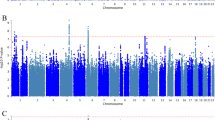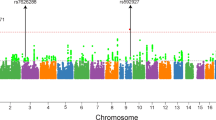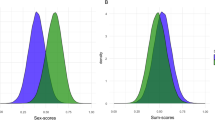Abstract
Chromosome 5q21–33 has been implicated in harboring risk genes for schizophrenia. In this paper, we report evidence that multiple single nucleotide polymorphisms in and around interleukin 3 (IL3) are associated with the disease in the Irish Study of High-Density Schizophrenia Families (ISHDSF), the Irish Case–Control Study of Schizophrenia (ICCSS) and the Irish Trio Study of Schizophrenia (ITRIO). The associations are sex-specific and depend on the family history (FH) of schizophrenia. In all three samples, rs31400 shows female-specific and FH-dependent associations (P=0.0062, 0.0647 and 0.0284 for the ISHDSF, ICCSS and ITRIO, respectively). Several markers have similar associations in one or two of the three samples. In haplotype analyses, identical risk and protective haplotypes are identified in the ISHDSF and ITRIO samples in several multimarker combinations. For ICCSS, the same haplotypes are implicated; however, the risk haplotypes observed in the family samples become protective. Several significant markers, rs440970, rs31400 and rs2069803, are located in and around known estrogen response elements, promoter and enhancer of the IL3 gene. They may explain the sex-specific associations and be functional for the expression of IL3 gene.
This is a preview of subscription content, access via your institution
Access options
Subscribe to this journal
Receive 12 print issues and online access
$259.00 per year
only $21.58 per issue
Buy this article
- Purchase on Springer Link
- Instant access to full article PDF
Prices may be subject to local taxes which are calculated during checkout

Similar content being viewed by others
References
Schwab SG, Eckstein GN, Hallmayer J, Lerer B, Albus M, Borrmann M et al. Evidence suggestive of a locus on chromosome 5q31 contributing to susceptibility for schizophrenia in German and Israeli families by multipoint affected sib-pair linkage analysis. Mol Psychiatry 1997; 2: 156–160.
Straub RE, MacLean CJ, O'Neill FA, Walsh D, Kendler KS . Support for a possible schizophrenia vulnerability locus in region 5q22–31 in Irish families. Mol Psychiatry 1997; 2: 148–155.
Straub RE, MacLean CJ, Ma Y, Webb BT, Myakishev MV, Harris-Kerr C et al. Genome-wide scans of three independent sets of 90 Irish multiplex schizophrenia families and follow-up of selected regions in all families provides evidence for multiple susceptibility genes. Mol Psychiatry 2002; 7: 542–559.
Straub RE, Jiang Y, MacLean CJ, Ma Y, Webb BT, Myakishev MV et al. Genetic variation in the 6p22.3 gene DTNBP1, the human ortholog of the mouse dysbindin gene, is associated with schizophrenia. Am J Hum Genet 2002; 71: 337–348.
Stefansson H, Sigurdsson E, Steinthorsdottir V, Bjornsdottir S, Sigmundsson T, Ghosh S et al. Neuregulin 1 and susceptibility to schizophrenia. Am J Hum Genet 2002; 71: 877–892.
Duan J, Martinez M, Sanders AR, Hou C, Saitou N, Kitano T et al. Polymorphisms in the trace amine receptor 4 (TRAR4) gene on chromosome 6q23.2 are associated with susceptibility to schizophrenia. Am J Hum Genet 2004; 75: 624–638.
Bourdeau V, Deschenes J, Metivier R, Nagai Y, Nguyen D, Bretschneider N et al. Genome-wide identification of high-affinity estrogen response elements in human and mouse. Mol Endocrinol 2004; 18: 1411–1427.
Cockerill PN . Mechanisms of transcriptional regulation of the human IL-3/GM-CSF locus by inducible tissue-specific promoters and enhancers. Crit Rev Immunol 2004; 24: 385–408.
Burdach S, Nishinakamura R, Dirksen U, Murray R . The physiologic role of interleukin-3, interleukin-5, granulocyte-macrophage colony-stimulating factor, and the beta c receptor system. Curr Opin Hematol 1998; 5: 177–180.
Powell HC, Garrett RS, Brett FM, Chiang CS, Chen E, Masliah E et al. Response of glia, mast cells and the blood brain barrier, in transgenic mice expressing interleukin-3 in astrocytes, an experimental model for CNS demyelination. Brain Pathol 1999; 9: 219–235.
Sugita Y, Zhao B, Shankar P, Dunbar CE, Doren S, Young HA et al. CNS interleukin-3 (IL-3) expression and neurological syndrome in antisense-IL-3 transgenic mice. J Neuropathol Exp Neurol 1999; 58: 480–488.
Giralt M, Carrasco J, Penkowa M, Morcillo MA, Santamaria J, Campbell IL et al. Astrocyte-targeted expression of interleukin-3 and interferon-alpha causes region-specific changes in metallothionein expression in the brain. Exp Neurol 2001; 168: 334–346.
Reddy EP, Korapati A, Chaturvedi P, Rane S . IL-3 signaling and the role of Src kinases, JAKs and STATs: a covert liaison unveiled. Oncogene 2000; 19: 2532–2547.
Jarskog LF, Glantz LA, Gilmore JH, Lieberman JA . Apoptotic mechanisms in the pathophysiology of schizophrenia. Prog Neuropsychopharmacol Biol Psychiatry 2005; 29: 846–858.
Zhang XY, Zhou DF, Zhang PY, Wu GY, Cao LY, Shen YC . Elevated interleukin-2, interleukin-6 and interleukin-8 serum levels in neuroleptic-free schizophrenia: association with psychopathology. Schizophr Res 2002; 57: 247–258.
Brown AS, Hooton J, Schaefer CA, Zhang H, Petkova E, Babulas V et al. Elevated maternal interleukin-8 levels and risk of schizophrenia in adult offspring. Am J Psychiatry 2004; 161: 889–895.
Sirota P, Schild K, Elizur A, Djaldetti M, Fishman P . Increased interleukin-1 and interleukin-3 like activity in schizophrenic patients. Prog Neuropsychopharmacol Biol Psychiatry 1995; 19: 75–83.
Kendler KS, McGuire M, Gruenberg AM, O'Hare A, Spellman M, Walsh D . The roscommon family study. III. Schizophrenia-related personality disorders in relatives. Arch Gen Psychiatry 1993; 50: 781–788.
Kendler KS, Myers JM, O'Neill FA, Martin R, Murphy B, MacLean CJ et al. Clinical features of schizophrenia and linkage to chromosomes 5q, 6p, 8p, and 10p in the Irish Study of High-Density Schizophrenia Families. Am J Psychiatry 2000; 157: 402–408.
Endicott J, Andreasen N, Spitzer RL . Family History Research Diagnostic Criteria. New York State Psychiatric Institute: New York, 1978.
Livak KJ . Allelic discrimination using fluorogenic probes and the 5′ nuclease assay. Genet Anal 1999; 14: 143–149.
Chen X, Levine L, Kwok PY . Fluorescence polarization in homogeneous nucleic acid analysis. Genome Res 1999; 9: 492–498.
van den Oord EJ, Jiang Y, Riley BP, Kendler KS, Chen X . FP-TDI SNP scoring by manual and statistical procedures: a study of error rates and types. Biotechniques 2003; 34: 610–620, 622.
Bedell JA, Korf I, Gish W . MaskerAid: a performance enhancement to RepeatMasker. Bioinformatics 2000; 16: 1040–1041.
Wigginton JE, Cutler DJ, Abecasis GR . A note on exact tests of Hardy–Weinberg equilibrium. Am J Hum Genet 2005; 76: 887–893.
Martin ER, Monks SA, Warren LL, Kaplan NL . A test for linkage and association in general pedigrees: the pedigree disequilibrium test. Am J Hum Genet 2000; 67: 146–154.
Dudbridge F . Pedigree disequilibrium tests for multilocus haplotypes. Genet Epidemiol 2003; 25: 115–121.
Excoffier L, Slatkin M . Maximum-likelihood estimation of molecular haplotype frequencies in a diploid population. Mol Biol Evol 1995; 12: 921–927.
Barrett JC, Fry B, Maller J, Daly MJ . Haploview: analysis and visualization of LD and haplotype maps. Bioinformatics 2005; 21: 263–265.
Gabriel SB, Schaffner SF, Nguyen H, Moore JM, Roy J, Blumenstiel B et al. The structure of haplotype blocks in the human genome. Science 2002; 296: 2225–2229.
Abecasis GR, Cherny SS, Cookson WO, Cardon LR . Merlin – rapid analysis of dense genetic maps using sparse gene flow trees. Nat Genet 2002; 30: 97–101.
O'Lone R, Frith MC, Karlsson EK, Hansen U . Genomic targets of nuclear estrogen receptors. Mol Endocrinol 2004; 18: 1859–1875.
Bjornstrom L, Sjoberg M . Mechanisms of estrogen receptor signaling: convergence of genomic and nongenomic actions on target genes. Mol Endocrinol 2005; 19: 833–842.
Speirs V, Birch MA, Boyle-Walsh E, Green AR, Gallagher JA, White MC . Interleukin-3: a putative protective factor against breast cancer which is secreted by male but not female breast fibroblasts. Int J Cancer 1995; 61: 416–419.
Yang X, Schadt EE, Wang S, Wang H, Arnold AP, Ingram-Drake L et al. Tissue-specific expression and regulation of sexually dimorphic genes in mice. Genome Res 2006; 16: 995–1004.
Chang HS, Kim JS, Lee JH, Cho JI, Rhim TY, Uh ST et al. A single nucleotide polymorphism on the promoter of eotaxin1 associates with its mRNA expression and asthma phenotypes. J Immunol 2005; 174: 1525–1531.
D'Adamo M, Perego L, Cardellini M, Marini MA, Frontoni S, Andreozzi F et al. The -866A/A genotype in the promoter of the human uncoupling protein 2 gene is associated with insulin resistance and increased risk of type 2 diabetes. Diabetes 2004; 53: 1905–1910.
Shifman S, Bronstein M, Sternfeld M, Pisante-Shalom A, Lev-Lehman E, Weizman A et al. A highly significant association between a COMT haplotype and schizophrenia. Am J Hum Genet 2002; 71: 1296–1302.
Chen X, Wang X, O'Neill AF, Walsh D, Kendler KS . Variants in the catechol-o-methyltransferase (COMT) gene are associated with schizophrenia in Irish high-density families. Mol Psychiatry 2004; 9: 962–967.
Chowdari KV, Mirnics K, Semwal P, Wood J, Lawrence E, Bhatia T et al. Association and linkage analyses of RGS4 polymorphisms in schizophrenia. Hum Mol Genet 2002; 11: 1373–1380.
Stefansson H, Sarginson J, Kong A, Yates P, Steinthorsdottir V, Gudfinnsson E et al. Association of neuregulin 1 with schizophrenia confirmed in a Scottish population. Am J Hum Genet 2003; 72: 83–87.
Li T, Stefansson H, Gudfinnsson E, Cai G, Liu X, Murray RM et al. Identification of a novel neuregulin 1 at-risk haplotype in Han schizophrenia Chinese patients, but no association with the Icelandic/Scottish risk haplotype. Mol Psychiatry 2004; 9: 698–704.
Funke B, Finn CT, Plocik AM, Lake S, DeRosse P, Kane JM et al. Association of the DTNBP1 locus with schizophrenia in a U.S. population. Am J Hum Genet 2004; 75: 891–898.
Chen X, Dunham C, Kendler S, Wang X, Oneill F, Walsh D et al. Regulator of G-protein signaling 4 (RGS4) gene is associated with schizophrenia in Irish high density families. Am J Med Genet 2004; 129B: 23–26.
van den Oord EJ, Sullivan PF, Jiang Y, Walsh D, Neill FA, Kendler KS et al. Identification of a high-risk haplotype for the dystrobrevin binding protein 1 (DTNBP1) gene in the Irish study of high-density schizophrenia families. Mol Psychiatry 2003; 8: 499–510.
Schwab SG, Knapp M, Mondabon S, Hallmayer J, Borrmann-Hassenbach M, Albus M et al. Support for association of schizophrenia with genetic variation in the 6p22.3 gene, dysbindin, in sib-pair families with linkage and in an additional sample of triad families. Am J Hum Genet 2003; 72: 185–190.
Kirov G, Ivanov D, Williams NM, Preece A, Nikolov I, Milev R et al. Strong evidence for association between the dystrobrevin binding protein 1 gene (DTNBP1) and schizophrenia in 488 parent-offspring trios from Bulgaria. Biol Psychiatry 2004; 55: 971–975.
Williams NM, Preece A, Morris DW, Spurlock G, Bray NJ, Stephens M et al. Identification in 2 independent samples of a novel schizophrenia risk haplotype of the dystrobrevin binding protein gene (DTNBP1). Arch Gen Psychiatry 2004; 61: 336–344.
Neale BM, Sham PC . The future of association studies: gene-based analysis and replication. Am J Hum Genet 2004; 75: 353–362.
Munafo MR, Thiselton DL, Clark TG, Flint J . Association of the NRG1 gene and schizophrenia: a meta-analysis. Mol Psychiatry 2006; 11: 539–546.
Souverein OW, Zwinderman AH, Tanck MW . Multiple imputation of missing genotype data for unrelated individuals. Ann Hum Genet 2006; 70: 372–381.
McGrath J, Saha S, Welham J, El Saadi O, MacCauley C, Chant D . A systematic review of the incidence of schizophrenia: the distribution of rates and the influence of sex, urbanicity, migrant status and methodology. BMC Med 2004; 2: 13.
Halbreich U, Kahn LS . Hormonal aspects of schizophrenias: an overview. Psychoneuroendocrinology 2003; 28 (Suppl 2): 1–16.
Tan EC, Chong SA, Wang H, Chew-Ping LE, Teo YY . Gender-specific association of insertion/deletion polymorphisms in the nogo gene and chronic schizophrenia. Brain Res Mol Brain Res 2005; 139: 212–216.
Thomson PA, Wray NR, Thomson AM, Dunbar DR, Grassie MA, Condie A et al. Sex-specific association between bipolar affective disorder in women and GPR50, an X-linked orphan G protein-coupled receptor. Mol Psychiatry 2005; 10: 470–478.
Salem JE, Kring AM . The role of gender differences in the reduction of etiologic heterogeneity in schizophrenia. Clin Psychol Rev 1998; 18: 795–819.
Czlonkowska A, Ciesielska A, Gromadzka G, Kurkowska-Jastrzebska I . Estrogen and cytokines production – the possible cause of gender differences in neurological diseases. Curr Pharm Des 2005; 11: 1017–1030.
Cahill L . Why sex matters for neuroscience. Nat Rev Neurosci 2006; 7: 477–484.
Van Den BA, Schumacher J, Schulze TG, Otte AC, Ohlraun S, Kovalenko S et al. The DTNBP1 (dysbindin) gene contributes to schizophrenia, depending on family history of the disease. Am J Hum Genet 2003; 73: 1438–1443.
Jones AL, Mowry BJ, Pender MP, Greer JM . Immune dysregulation and self-reactivity in schizophrenia: do some cases of schizophrenia have an autoimmune basis? Immunol Cell Biol 2005; 83: 9–17.
Mitsiades CS, Mitsiades N, Koutsilieris M . The Akt pathway: molecular targets for anti-cancer drug development. Curr Cancer Drug Targets 2004; 4: 235–256.
Wierzba-Bobrowicz T, Lewandowska E, Kosno-Kruszewska E, Lechowicz W, Pasennik E, Schmidt-Sidor B . Degeneration of microglial cells in frontal and temporal lobes of chronic schizophrenics. Folia Neuropathol 2004; 42: 157–165.
Jarskog LF, Selinger ES, Lieberman JA, Gilmore JH . Apoptotic proteins in the temporal cortex in schizophrenia: high Bax/Bcl-2 ratio without caspase-3 activation. Am J Psychiatry 2004; 161: 109–115.
Hanninen K, Katila H, Rontu R, Mattila KM, Hurme M, Lehtimaki T . Tumor necrosis factor-alpha – G308A polymorphism in schizophrenia in a Finnish population. Neurosci Lett 2005; 385: 76–81.
Emamian ES, Hall D, Birnbaum MJ, Karayiorgou M, Gogos JA . Convergent evidence for impaired AKT1-GSK3beta signaling in schizophrenia. Nat Genet 2004; 36: 131–137.
Nadri C, Dean B, Scarr E, Agam G . GSK-3 parameters in postmortem frontal cortex and hippocampus of schizophrenic patients. Schizophr Res 2004; 71: 377–382.
Natarajan C, Sriram S, Muthian G, Bright JJ . Signaling through JAK2-STAT5 pathway is essential for IL-3-induced activation of microglia. Glia 2004; 45: 188–196.
Hanson DR, Gottesman II . Theories of schizophrenia: a genetic-inflammatory-vascular synthesis. BMC Med Genet 2005; 6: 7.
Yu L, Yang MS, Zhao J, Shi YY, Zhao XZ, Yang JD et al. An association between polymorphisms of the interleukin-10 gene promoter and schizophrenia in the Chinese population. Schizophr Res 2004; 71: 179–183.
Rosa A, Peralta V, Papiol S, Cuesta MJ, Serrano F, Martinez-Larrea A et al. Interleukin-1beta (IL-1beta) gene and increased risk for the depressive symptom-dimension in schizophrenia spectrum disorders. Am J Med Genet B Neuropsychiatr Genet 2004; 124: 10–14.
Bessler H, Levental Z, Karp L, Modai I, Djaldetti M, Weizman A . Cytokine production in drug-free and neuroleptic-treated schizophrenic patients. Biol Psychiatry 1995; 38: 297–302.
Yamada R, Tanaka T, Unoki M, Nagai T, Sawada T, Ohnishi Y et al. Association between a single-nucleotide polymorphism in the promoter of the human interleukin-3 gene and rheumatoid arthritis in Japanese patients, and maximum-likelihood estimation of combinatorial effect that two genetic loci have on susceptibility to the disease. Am J Hum Genet 2001; 68: 674–685.
Gorwood P, Pouchot J, Vinceneux P, Puechal X, Flipo RM, De Bandt M et al. Rheumatoid arthritis and schizophrenia: a negative association at a dimensional level. Schizophr Res 2004; 66: 21–29.
Acknowledgements
This study is supported by a research grant (RO1MH41953) to KSK from the National Institute of Mental Health and by a young investigator award to XC from the National Alliance for Research on Schizophrenia and Depression. We thank the patients and their families for participating in this study.
Author information
Authors and Affiliations
Corresponding author
Rights and permissions
About this article
Cite this article
Chen, X., Wang, X., Hossain, S. et al. Interleukin 3 and schizophrenia: the impact of sex and family history. Mol Psychiatry 12, 273–282 (2007). https://doi.org/10.1038/sj.mp.4001932
Received:
Revised:
Accepted:
Published:
Issue Date:
DOI: https://doi.org/10.1038/sj.mp.4001932
Keywords
This article is cited by
-
Functional Polymorphism in the Interleukin-6 and Interleukin-10 Genes in Patients with Paranoid Schizophrenia —A Case-Control Study
Journal of Molecular Neuroscience (2010)
-
Association study of CSF2RB with schizophrenia in Irish family and case – control samples
Molecular Psychiatry (2008)
-
Converging evidence for a pseudoautosomal cytokine receptor gene locus in schizophrenia
Molecular Psychiatry (2007)



